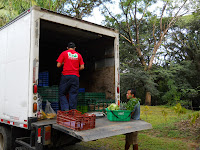
While they were here, the blog was a periodic topic of conversation. Specifically, this week's topic. We batted around several topics but eventually settled on food.
So much of our lives here revolve around food. The finding of, the buying of, the preparation of, the eating of, the cleaning up after of, etc. Food provides sustenance, satisfaction, frustration, adventure, entertainment, and creates and strengthens friendships.
Take ice cream, for example.
You may remember that our first guests to the casita kindly lugged with them a rather large and heavy ice cream maker. Once washed and plugged in, the hum of the motor became the constant soundtrack to our lives at home. Ian experimented with flavors and friends and family provided willing assistance as official tasters. A few batches later, a few conversations later, and "¡Que Rico! - Helado Natural de Nosara" was officially launched!

Deals were made, spreadsheets were created, and labels were drafted, printed and taped. Salted caramel was created as the signature flavor and, voila, we have an income! (Get your cup at Market Organico or the Beach Dog Cafe now!) Granted, the profit from a batch of ice cream is minimal, but no one is complaining at the bonus dinner out each month. Food begets food.
The salted caramel flavor was launched first because: 1) it is darn good, and 2) all ingredients are available locally. Which brings us to food begets friendships. Ian's search for good, fresh ingredients led him to a local farm where we now purchase fresh raw milk and fresh eggs. The owners of the farm are wonderful, nice and generous people. We brought them a sample of the ice cream made with their milk and eggs and they sent us home with a huge bag full of langostinos they had caught the night before in the river.
They also invited us to come back to help make juice from sugar cane. Their small sugar cane mill is powered by a horse that walks in a circle pulling a beam of wood which turns the gears of the mill. While the gears are turning, the sugar cane is pushed between heavy rollers. The kids worked hard pushing the cane in and were rewarded with a ride on the horse and a taste of fresh sugar cane juice over ice. Food begets adventure.

Food also begets conversation. Guests to Nosara are treated to endless discussions on food. What we can and can't get, how much it costs, the best and the worst of, what we wish for, what we have had enough of....
We describe the typical costa rican "casado" lunch of salad, rice, beans and meat or fish, and compare and contrast our favorite lunch spots.

 We talk about how we can get fresh bread from the bread truck and fresh fruits and vegetables from the fruit and veggie truck.
We talk about how we can get fresh bread from the bread truck and fresh fruits and vegetables from the fruit and veggie truck.
We describe how Sadie and Ian figured out how to get fresh fish from a house on the beach before it gets delivered to the fish markets.

We talk about getting great cheese (ordered in advance now) and organic greens at the farmer's market. We talk about our rental property and its mango, banana and lime trees. We talk about the price of olive oil and soy sauce.
 We love to compare and contrast for our guests the ceviche in various establishments. Who uses what kind of fish, which one is the freshest, which one is the spiciest. No visit with us is complete without a trip to the gas station to where the best ceviche is sold from a small table near the pumps
We love to compare and contrast for our guests the ceviche in various establishments. Who uses what kind of fish, which one is the freshest, which one is the spiciest. No visit with us is complete without a trip to the gas station to where the best ceviche is sold from a small table near the pumps (which explains why our car always has a slight smell of fish - eating a cup of ceviche on the Nosara roads is definitely a challenge).
(which explains why our car always has a slight smell of fish - eating a cup of ceviche on the Nosara roads is definitely a challenge).We have a lot to say about food and I'm certain it is as fascinating a topic for our guests as it is for us. Right? Right??
With guests we relish in the relatively rare treat of dinner out (fish and tempura at our favorite restaurant on the beach or pizza at our favorite Italian restaurant), but we also relish in the joy of cooking and eating at home together. Food strengthens bonds.
With the Miller-Ouimets, in addition to spending close to 20 years in each others' kitchens, we have spent many vacations together, renting houses on the Russian River, Hawaii, and Mexico. We fall easily into our comfortable and collaborative roles for cooking and cleaning for six. Over food we all share stories and opinions, we laugh, we discuss the day we've just had and we plan for tomorrow. For entertainment we watch the geckos catching and eating insects, and the monkeys eating flowers and leaves.
Finally, as our guests leave, we send them off with hugs and plenty of snacks for the long journey home.









































